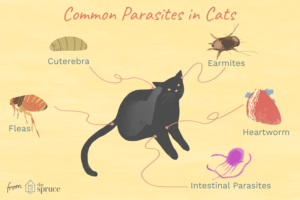Even 30 years ago, according to veterinarians, about 90% of cats in Europe were constantly affected by several types of parasites at once. And even now, parasitic diseases are extremely common. If, for example, the owner takes his pet to the country in the summer, the risk of infection of the pet will increase significantly. In addition, there are parasites that live on the animal’s body constantly.
However, recently veterinary pharmacology has made a big step forward, and the general availability of antiparasitic drugs has increased. Moreover, with adequate medical care, most parasites today pose significantly less danger than 30 years ago. But what are they like? How can the owner recognize if his pet is infected? What should I do if they appear?
What types and types of parasites are isolated today?
Most often, parasites are distinguished by their location. So, external parasites (ectoparasites) include:
- Fleas, еhey live in the animal’s coat
- lice, also found in the fur of cats
- ear mites (otodectosis), They live in the ears of an animal
- Ixode ticks, a cat can bring these parasites, for example, from a walk
There are also internal parasites that live in the gastrointestinal tract of a cat. This group includes various kinds of helminths:
- round and tapeworms and flukes
- among which nematodes
- ascarids are most common
- dirofilaria (cardiac)
How can cat parasites be dangerous?
- Some types of parasites that are dangerous to cats can also be dangerous to their owners: for example, some types of helminths, fleas.
- Parasites usually feed at the expense of their host: skin scales, sebaceous gland secretions, blood (like a flea or hookworm). This often causes pain and anxiety to the animal, and in severe cases they can cause anemia – anemia.
- Many blood-sucking parasites are carriers of dangerous diseases that can pose a risk to the life and health of a pet. These include, for example, infectious anemia of cats, which is carried by both ticks and fleas.
- Fleas can provoke various skin inflammations, and helminths significantly reduce the immune status of cats.
- A sick pet can infect other animals living in your home.
How to diagnose parasites at home?
The correct answer is that it is almost impossible to do this. There are too many nuances in the diagnosis of parasites, and some of them are too subtle to detect them, especially at first. Therefore, the cat should undergo regular medical examinations at your veterinary clinic, and you should not forget to monitor her health indicators.
Pay close attention to the skin and coat, the condition of the mucous membranes and the quality of your pet’s stool, and if any abnormalities occur, contact a doctor who will be able to correctly diagnose the disease, and if necessary prescribe treatment.
What are the symptoms that are alarming?
The pet’s treatment is prescribed by a doctor, but you must be vigilant in order to distinguish the signs of a possible disease in time. If you notice any of the symptoms listed below, consult a veterinary specialist immediately:
- helminths or their eggs in the feces or vomit of a cat
- fleas, lice or ticks in the cat’s fur
- severe scratching and traumatic hair loss
- general lethargy and malaise of the pet
- pale mucous membranes, changes in the color and texture of feces
How to prevent infection with parasites?
Comprehensive protection of cats from parasites consists in carrying out regular preventive measures.
So, to combat internal parasites, it is recommended to use combined anthelmintic agents that effectively protect animals from most helminths. As a rule, once a quarter, broad-spectrum drugs are used in the form of tablets or suspensions in preventive doses.
Prevention of the appearance of external parasites in cats consists mainly in external treatments in the warm season — from May to October. There are a large number of antiparasitic drugs on the market of animal products. Currently, the most popular are easy-to-use and quite effective drops that are applied to the pet’s skin in the withers area. To form a stable protection against the entire spectrum of external parasites, it is enough to treat the animal once every 3-4 weeks.
For the final determination of drugs for your cat and the frequency of their use, it is necessary to consult with a veterinarian.
How to provide emergency assistance to a cat for various diseases, read the following article.

